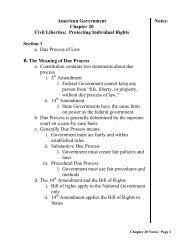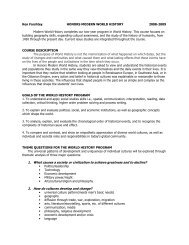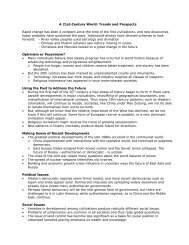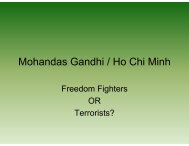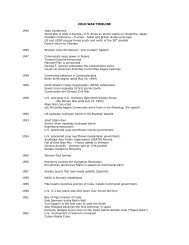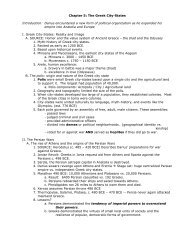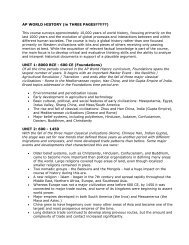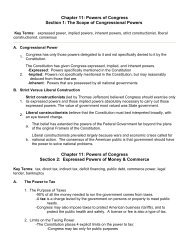Jainism and Buddhism
Jainism and Buddhism
Jainism and Buddhism
You also want an ePaper? Increase the reach of your titles
YUMPU automatically turns print PDFs into web optimized ePapers that Google loves.
• Their goal was to achieve moksha —liberation from the cycle of birth,death, <strong>and</strong> rebirth or reaching thebest karma that you could actuallyreach.• The ideas of these religiousdissidents are reflected in theUpanishads.
<strong>Jainism</strong>• Founded by Mahavira - lived between 599<strong>and</strong> 527 B.C.E.• Belief that everything in the universe hasa soul <strong>and</strong> because of this should not beharmed• Had to take occupations that would notharm any creature– Tradition of working in trade <strong>and</strong>commerce– Extremely wealthy community
<strong>Jainism</strong>• Jains practiced nonviolence<strong>and</strong> went to extremes intheir attempts not to killany living thing• The most extreme wentnaked <strong>and</strong> starvedthemselves to death.• Brush ants from their path• Wear masks to notaccidentally suck in bugs
<strong>Buddhism</strong> Basics• Attempts to give answers to life’s s questions• Emphasis on “things to do” rather than “things to believe”• Avoid speculative questions (creation, Supreme power,afterlife) since there was little possibility of definitive answers instead spend time attempting to deal with the harshrealities presented by life here <strong>and</strong> now• Tolerant to any religion that allows a person to find “truth” ofhimself/ herself. Believe that setting an example which othersmay emulate.• ULTIMATE GOAL end suffering <strong>and</strong> attain absolute peace<strong>and</strong> joy
SIDDHARTHA GAUTAMA• Siddhartha Gautama born563 BCE into Kshatriyacaste in present dayNepalBUDDHA= ENLIGHTENED ONE• Kingdom of Gautama• Siddhartha had alegendary birth, life <strong>and</strong>death• Prophecy given to hisfather…
Miracles, miracles, miracles…• Immaculate conception -Siddhartha descended fromHeaven <strong>and</strong> entered mother’s(Queen Maya) womb in form ofbaby white elephant (purity)• Queen Maya carried Siddharthafor 10 months <strong>and</strong> could seehim in the womb• Gave birth from her side withassistance from tree branches• Water poured from the sky• At birth Siddhartha took 7 steps<strong>and</strong> said “this is my last birth”
Four Sights• King wanted toshelter Siddharthafrom unpleasantnessof life• At 29, Siddharthavisited the city <strong>and</strong>saw four sights:1) Old man2) Sick man3) Dead man4) Ascetic monk
FOUR SIGHTSThese sightscompelled him toreflect upon:• suffering• death• meaning of life• ultimate fate ofman<strong>and</strong> inspired himto find a spiritualsolution toproblems ofhuman life
• He left his palace <strong>and</strong> for 7years searched for theultimate truth of life• Studied Hindu scriptures butfound them lacking• Tried raja yoga (meditation)but sensed his sacrifices werenot great enough• turned to asceticism <strong>and</strong>scourged <strong>and</strong> starved himself(1 grain of rice a day) = butno deep insight came• Determined best course wasthe MIDDLE WAY (pathbetween both extremes; alifestyle of moderation)
ENLIGHTENMENT OF BUDDHA• Under a Bodhi tree (tree ofWisdom) he meditated• Remembered all of his previouslives• Resisted the combats of Mara(Evil One), who tried manytemptations• Removed craving <strong>and</strong> ignorancefor himself• At dawn of his 35 th birthday, hismind “pierced the bubble” of theuniverse, enabling him to realizethe essential truth about life <strong>and</strong>the path to salvation• Achieved NIRVANA <strong>and</strong> wasreleased from samsara (endlesscycle)• Stayed in this state for 7 daysNIRVANA= state of supreme realization <strong>and</strong>enlightenment= underst<strong>and</strong> truth of life <strong>and</strong>freedom from ignorance= state of total liberation, truth,tranquility, peace
ENLIGHTENMENT NEW RELIGION• After achieving enlightenment, Buddha wanted to share hisexperiences <strong>and</strong> insights with others <strong>and</strong> traveled to Benares<strong>and</strong> encountered five ascetics.Argued that no rituals, gods or any type of outside power couldsave man. The only salvation lies in the realization of the FourNoble Truths <strong>and</strong> the diligent pursuit of the Eight Fold Path• Within years, Buddhist monasteries were emerging throughoutIndia, establishing <strong>Buddhism</strong> as a religion• The Buddha died in 486 BCE <strong>and</strong> achieved paranirvana(complete nirvana)
What do Buddhists believe?• Rebirth (reincarnation) results from attachments (karma)• Nirvana is a peaceful, detached state of mind• Achieving Nirvana means escape from the cycle of rebirth(samsara)Once Gautama Buddha died, after 80 years of life in thisworld, having achieved Nirvana <strong>and</strong> teaching multitudes hisway of life, he ceased to exist as a distinct being• <strong>Buddhism</strong> is non-theistic:Buddha is not the BuddhistGod – he is just a revered teacher
3 Characteristics of Existence• Annica = impermanence(world in constant flux)• Dukkha = dissatisfaction(all humans <strong>and</strong> animalsexperience suffering)ANNICADUKKHA• Anatta = no self(no separate, eternalunchanging self)ANATTA
FOUR NOBLE TRUTHS
What is the fundamentalcause of all suffering? Therefore, extinguish the self, don’tobsess about oneself.
Fundamental Ethicsof <strong>Buddhism</strong> is theEightfold Path.Buddhist scripturesare filled with storiesillustrating compassion,charity <strong>and</strong> non-violence
What is the Eight-Fold Path?Wisdom:•Right underst<strong>and</strong>ing•Right motivationMoral discipline:•Right speech•Right action•Right livelihoodMental discipline:•Right effort•Right mindfulness•Right meditation
Eightfold Path The union with the ultimatespiritual reality. Escape from the cycle ofrebirth.
FIVE PRECEPTS1) Abstain from killing orharming living beings2) Abstain from stealing3) Abstain from impropersexual conduct4) Abstain from falsespeech5) Abstain from takingalcohol <strong>and</strong> harmfuldrugs
More Numbers <strong>and</strong> Concepts…• Triple Jewel or Three Refuges: : Buddha(guide), Dharma (path), Sangha (teachers)• Six Perfections: : giving, morality, patience,vigor, meditation <strong>and</strong> wisdom• Bodhisattva: : person who has attained nirvanabut chooses to be reborn within samsara inorder to help others on path of enlightenment• Nirvana: : escape from cycle of rebirth (basedon karma, 8-fold 8path, enlightenment) to attainperfect freedom <strong>and</strong> bliss
Symbols• Wheel of Life• M<strong>and</strong>ala• Lotus Flower• Stupa• Temples• Swastika• Buddhapada
Hinduism vs <strong>Buddhism</strong>• Buddha rejected Hindu belief that human inequality was based onhereditary distinctions <strong>and</strong> that salvation can only be achieved byelite few• Same concepts: : reincarnation, samsara, , karma, dharma, nirvana,raja yoga (meditation which held the key to enlightenment <strong>and</strong> thesalvation of nirvana)• Rejected concepts: : caste system, Hindu rituals <strong>and</strong> offerings togods, theories, language of Sanskrit (he used Pali), nirvana only ifBrahmin caste, refusal to accept authority of Vedas <strong>and</strong> Upanishads• <strong>Buddhism</strong> view of Women: more equal in stance compared toHinduism; women may endure more “suffering” (ie.. childbirth).Buddha allowed either men or women from any caste to becomemonks or nuns <strong>and</strong> join the Sangha (brotherhood)
How does <strong>Buddhism</strong> differ fromHinduism?<strong>Buddhism</strong> rejects…• Authority of the ancient Vedic texts• The Vedic caste system• The Vedic <strong>and</strong> Hindu deities• The efficacy of Vedic worship <strong>and</strong> ritual• The concept of Brahman
How does <strong>Buddhism</strong> differ from<strong>Jainism</strong>?<strong>Buddhism</strong> rejects…• The concept of Atman (eternal spirit / soul)• The practice of strict asceticism <strong>and</strong>withdrawal from the world (preferring the“middle way”)• Vegetarianism as required
<strong>Buddhism</strong> 101Founded:• 6 th century BCEFounder:• Siddhartha Gautama,otherwise known as theBuddha “EnlightenedOne”Place of Origin:• IndiaSacred Books:• oldest <strong>and</strong> mostimportant scriptures arethe Tripitaka, , (The ThreeBaskets of Wisdom)Number of Adherents:• approximately 200 million closeadherents, although someestimates surpass the 600 millionmark. Precision is impossible…Distribution:• predominant faith in Burma,Ceylon, Thail<strong>and</strong> <strong>and</strong> Indo-China.It also has followers in China,Korea, Mongolia <strong>and</strong> Japan.Sects:• two principal schools areMahayana <strong>and</strong> Theravadin (orHinayana) ) <strong>Buddhism</strong>
Religion or Philosophy?Religion• Attempts to examine themeaning of life <strong>and</strong> universse• Provides an ethical st<strong>and</strong>ard<strong>and</strong> an overall goald beyondthis life• Despite Buddha’s s wishes, hewas defied after his death bysome of his followers• <strong>Buddhism</strong> has taken on rituals,sacrifices, temple worship,elaborate scriptures <strong>and</strong>complex doctrinesPhilosophy• No sacrifices, worship, prayers,rituals• Rejected the principle ofauthority in religious matters• No god personified fatherfigure who created <strong>and</strong>presided over the universe• Buddha- not proclaimed as agod but stated that he was“awake” <strong>and</strong> could point theway for an individual towardssalvation
Impact of <strong>Buddhism</strong>• <strong>Buddhism</strong> elevated the level of religious life <strong>and</strong> thoughtin most Asia• Forced Hinduism to remedy some of its abuses <strong>and</strong>revitalize its teachings• Major effect upon philosophy, education, literature <strong>and</strong>art of south Asia, India (Gupta period), China (T’ang(Dynasty) <strong>and</strong> Japan (Zen <strong>Buddhism</strong>)• However, many argue <strong>Buddhism</strong> has discouraged socialprogress (since it accepts life as full of suffering <strong>and</strong>does not produce a great concern or solutions regardingpoverty, illiteracy, illness, pollution etc.)• Spread of Communism (Communist takeover of China in1949) led to nationalization of monasteries <strong>and</strong> allrevenues) government in exile in Tibet




